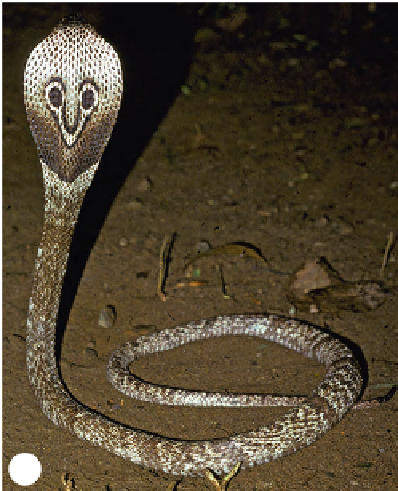Biology Reference
In-Depth Information
(A)
(B)
Plate 4.63
(A and B) Common Asian cobra, spectacled cobra, or Indian cobra; nag (
Naja
naja
), Sri Lanka.
The world's most medically important elapid snake,
N. naja
is responsible
for a large proportion of mortality and morbidity throughout its wide range. Some populations
produce postsynaptic neurotoxins, others necrotic cytotoxins, and a few produce a mixture
of the two. Therefore, envenomated patients may present with paralytic features/respiratory
failure, with severe locally necrotic disease, or, less commonly, a combination of these. The
weak hemolysin, “direct lytic factor,” synonymous with “cardiotoxin,” occurs in venoms of
some populations. Cardiotoxic effects are uncommonly documented, but have occurred in
some patients envenomated by this species, particularly in Malaysia. Various phases of this
species are popular in private collections. The long-confused taxonomy of the genus
Naja
has
been subjected to recent review, and continuing reassignments in this group are likely.
Photos copyright to David A. Warrell.
(June-September; 55.4%), and a notable decrease during the winter season (October-
January; 18.4%). This is similar to the data reported by De Silva (1976a) and parallels
the data reported for incidence of
P. olfersii
bites in Brazil (e.g., Ribeiro et al., 1999).
Peak incidence of bites occurred between 1700 hours and 2400 hours (42%), and the
least number of cases were recorded between 0100 and 0800 hours (9.55%; Saha and
Hati, 1998). As noted in the other few epidemiological studies of non-front-fanged
colubroid snake (“rear-fanged colubrid”) bites, in the West Bengali region the majority
of bites were inflicted on the victims' extremities; in this survey, the lower extremities
were most commonly affected (77.7%; Saha and Hati, 1998). Unfortunately, Saha and
Hati (1998) did not include any clinical detail of the presentations. They reported no
significant effects from the nonvenomous bites recorded in the study, but a 6.81% mor-
tality rate for the venomous bites. One of the authors previously reported an average



